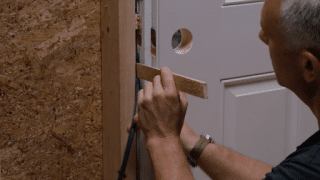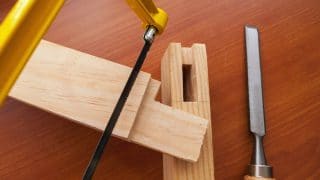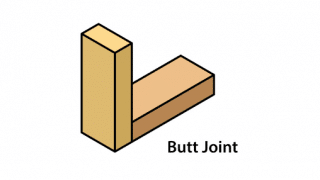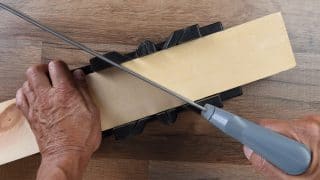
When choosing cabinet hardware there are countless options, but once you make a few key decisions about functionality and aesthetics you’ll be well on your way to completing your cabinet building project.
If your project includes a drawer system, corresponding drawer slides are an essential piece of hardware. Nearly all drawer slides are composed of two pieces: a drawer profile and a cabinet profile. The drawer profile attaches to the drawer and the cabinet profile attaches to the inside of the cabinet. Once the two pieces are attached, either a ball bearing or roller mechanism allows the slide to move.
Tip: Best practice is to build the cabinet box before building drawers. After assembling the cabinet box, choose your drawer slides, and build the drawers to the specifications of both the cabinet and the slide.
How to choose drawer slides
“In general in our shop, we typically gravitate toward hardware that is concealed. Most hardware is not very appealing to look at. So if we have the option to hide it, we’re going to do so.” – Ken DeCost
The three main types of slides correlate to how they are mounted—side mount, undermount, or center mount—and the decision is largely aesthetic. Beyond that, there are many different drawer slide manufacturers who offer optional features like soft close, slow motion close, locking, specialty finishes, or heavy duty weight ratings.
Learn how to select the right kind of drawer slide for any cabinet project with cabinet maker Ken DeCost in MT Copeland’s Introduction to Cabinetry online course.
Mount type
Where the drawer slides are mounted determines how concealed or visible the hardware is when the drawer is open. In Ken’s shop, they opt for concealed hardware whenever possible because it provides a more polished look. An added benefit is that concealed styles also tend to be higher quality—a win-win for clean aesthetics and better performance.
Side mount
Side mount drawer slides come in pairs and mount to the inside of the cabinet case and the side of the drawer. When you open the drawer, the slide is visible on the side of the drawer. They require planning for clearance between the cabinet opening and the drawer slides—typically ½ inch between the slides and the drawer front opening.
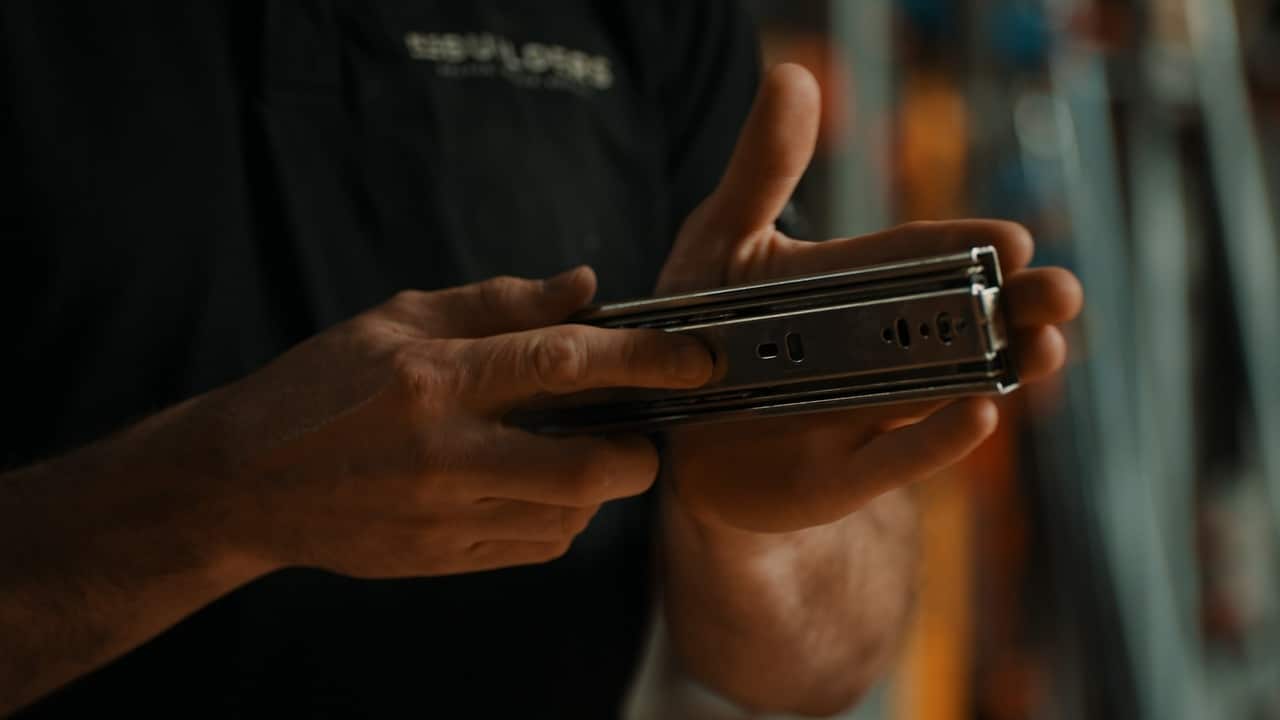
Under mount
Under mount drawer slides come in pairs and mount to the side of the cabinet case and the underside of the drawer along each side. They are not visible when the drawer is open. They require less clearance than side mount slides and are adjustable.
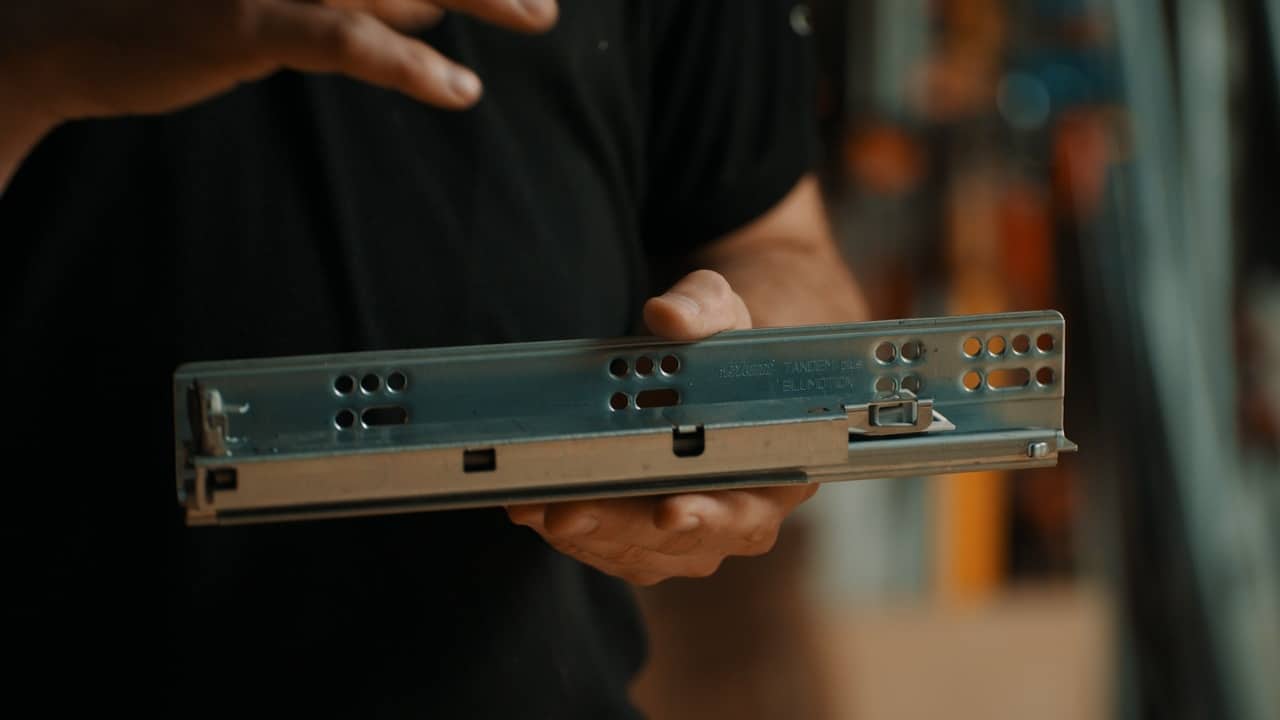
Center mount
Center mount slides come in a single piece that mounts to the center of the underside of the drawer. They are not visible when the drawer is open. Some require clearance depending on the thickness of the slide.
When choosing cabinet hardware there are countless options, but once you make a few key decisions about functionality and aesthetics you’ll be well on your way to completing your cabinet building project.
If your project includes a drawer system, corresponding drawer slides are an essential piece of hardware. Nearly all drawer slides are composed of two pieces: a drawer profile and a cabinet profile. The drawer profile attaches to the drawer and the cabinet profile attaches to the inside of the cabinet. Once the two pieces are attached, either a ball bearing or roller mechanism allows the slide to move.
Tip: Best practice is to build the cabinet box before building drawers. After assembling the cabinet box, choose your drawer slides, and build the drawers to the specifications of both the cabinet and the slide.
How to choose drawer slides
“In general in our shop, we typically gravitate toward hardware that is concealed. Most hardware is not very appealing to look at. So if we have the option to hide it, we’re going to do so.” – Ken DeCost
The three main types of slides correlate to how they are mounted—side mount, undermount, or center mount—and the decision is largely aesthetic. Beyond that, there are many different drawer slide manufacturers who offer optional features like soft close, slow motion close, locking, specialty finishes, or heavy duty weight ratings.
Learn how to select the right kind of drawer slide for any cabinet project with cabinet maker Ken DeCost in MT Copeland’s Introduction to Cabinetry online course.
Mount type
Where the drawer slides are mounted determines how concealed or visible the hardware is when the drawer is open. In Ken’s shop, they opt for concealed hardware whenever possible because it provides a more polished look. An added benefit is that concealed styles also tend to be higher quality—a win-win for clean aesthetics and better performance.
Side mount
Side mount drawer slides come in pairs and mount to the inside of the cabinet case and the side of the drawer. When you open the drawer, the slide is visible on the side of the drawer. They require planning for clearance between the cabinet opening and the drawer slides—typically ½ inch between the slides and the drawer front opening.

Under mount
Under mount drawer slides come in pairs and mount to the side of the cabinet case and the underside of the drawer along each side. They are not visible when the drawer is open. They require less clearance than side mount slides and are adjustable.

Center mount
Center mount slides come in a single piece that mounts to the center of the underside of the drawer. They are not visible when the drawer is open. Some require clearance depending on the thickness of the slide.
Length
Drawer slides typically range in length from 10 inches to 28 inches with specialty lengths available for custom drawers and unique applications. If the slide is too short the drawer will not pull out far enough and if the slide is too long the drawer will not fit in the cabinet.
For under mount drawer slides, the slides must be the same length as the drawer. For side mount and center mount slides, measure from the front edge of the cabinet box to the inside face of the cabinet back and choose the drawer slide that is the next size down from that measurement.
Extension
Extension is how far the drawer will extend when completely open. Consider how much access you need to the back of the drawer box and how much space the drawer has to extend out into the room. Here are the most common extension types:
- ¾: One quarter of the drawer remains in the cabinet when the drawer is fully extended. This is the most popular option and good for tight spaces where the drawer can’t fully extend into the room.
- Full: Telescopes to allow full extension and therefore full access. Good for when you need access to the back of the drawer.
- ⅞: An option between ¾ and full extension with only ⅛ of the drawer remaining in the cabinet when fully open.
- Over travel: Telescopes to go beyond full extension with full access to the drawer. Good for counters with an overhang where you still need access to the back of the drawer.
Weight rating
Capacities and weight ratings are similar across manufacturers and typically range from 75 to 100 lbs per drawer. Most home applications do not need strength beyond this, but consider the purpose of the drawer when choosing. For example, garage cabinet drawers holding heavy tools might require heavy duty slides.
In general, a ball bearing drawer slide will tend to carry more weight than a roller slide. Also keep in mind that a weight rating applies to a pair of slides. Two slides rated for 100 lbs does not equal a 200 lbs weight rating.
Finish
You only need to consider finish if you are using a type of drawer slide that is not concealed. Most drawer slides come in metal with a zinc finish. Some are available in a range of colors meant to match wood varieties and stains. Black and white are also easy to find. If you are on the hunt for a vintage look or unique style, talk to customer service at your local store to find what you need.
Motion features
Motion features like soft close drawer slides are becoming increasingly popular because they reduce noise from slamming and make closing a drawer as easy as a tap. Here are the most common motion features:
- Soft-close: Keeps drawers from slamming by slowly drawing them in.
- Self-close: Similar to soft close drawer slides and draws the drawer in with even less effort from the user.
- Push-to-open or touch-release: Simply press the drawer front to pop open the drawer. Good for modern styles that do not have external cabinet hardware.
- Locking: Lock the drawer into place when closed. Good for kitchen appliance stands, child safety, and boats and campers where drawers could open during travel.
MT Copeland offers video-based online classes that give you a foundation in construction fundamentals with real-world applications, like building cabinets. Classes include professionally produced videos taught by practicing craftspeople, and supplementary downloads like quizzes, blueprints, and other materials to help you master the skills.


